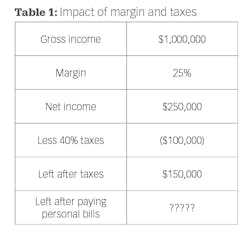The data in your practice tells a story. Is it good or bad?
Your practice data is telling you a story. If you’re not paying attention (i.e., tracking key metrics) and reacting appropriately to the ever-evolving plot, your story is likely to have a disappointing conclusion.
You don’t have to be an accomplished mathlete to run a practice, but you do have to understand a few essential financial concepts if you want a profitable and growing practice. Monitoring these few figures on a regular basis will tell you about the health of your business, where remedies may need to be applied to any ills, and how to strengthen your health for whatever lies ahead.
The reality of gross versus net income, margin, and taxes
Even the most seasoned business owners are dismayed each year to find out how much money they actually made compared to what they earned. We use information like the example in Table 1 to educate clients about the impact of margin and taxes on gross income. In this example, you can see that a million-dollar practice can easily result in less than $100,000 left in the bank.
Take control of your data
Gross income (production/collected revenue)
This data tells the story of either a healthy and growing practice, or a stagnant one that’s headed for difficult times. Driving more revenue to your top line is entirely within your control. Is your schedule full? Are your associates’ and hygienists’ schedules full? Are you investing in the patient experience and team training in ways that generate a steady stream of referrals?
Are you investing in marketing to create a steady stream of new patients? Are you offering add-on products and services that enhance the health and well-being of your patients? Do you have a strategic plan to add capacity by investing in an associate, another hygienist, or by expanding your space? Even if the answers are yes to all of these, if your team is inefficient and ineffective at collections, your practice will forever suffer from poor health.
Margin
The example in table 1 is based on a fairly typical margin of 25%, but it can range from 10% to 40%. If you’re only clearing 10% or 15% from your gross revenue or production, your data is telling a story of excessive overhead and/or operational inefficiencies. Take control by looking at all the ways you’re spending money that don’t directly enhance the patient experience, generate new patients, or develop your team. Critically assess if you’re getting a positive return on every dollar you spend, then rewrite that chapter.
Taxes
When it comes to taxes, you just have to accept that you’ll be coughing up nearly 40% of your net income. You can’t rewrite that chapter, so learn to live with it and focus on driving up overall practice revenue.
Predicting the future
If your practice is healthy, by far the best metric that predicts whether it will stay that way is your average number of new patients. If you’re not in great shape (aka, increasing), the correlation between stagnant revenue and low new-patient numbers will be unmistakable.
A steady stream of new patients is the lifeblood of any practice. You need to continually attract new patients via referrals and marketing throughout the life of your practice, and here’s why. Imagine a funnel in which you bring new patients in at the top. No matter how skilled a dentist you are, or how great your practice is, patients will always fall out the bottom due to natural attrition. Some will move, some will pass away, and some will simply move to the dentist down the street. Just to stay even you need to continually replace those you lose, then you need more to actually grow your practice. Bottom line is you simply cannot grow your practice without a strong flow of new patients, which is why this is the number one predictor of the short- and long-term health of your practice.
We use the following exercise to enlighten our clients on the correlation between revenue, collections, and new patients, specifically, the number of new patients needed to generate the level of revenue you want. Plug your actual numbers into these simple equations to calculate a new-patient target that will help you hit your revenue target.
Step 1: Calculate the average revenue per new patient (i.e., lifetime value of a new patient based on the ratio of collections to new patients during the same time period).
Total current collections ÷ Total current new patients = Current average revenue per new patient
Step 2: Calculate the number of new patients needed to reach your revenue goal.
Collection goal ÷ Current average revenue per new patient = Number of new patients needed
Your average revenue per new patient will likely change over time, but the enduring fact is that you can’t reach higher income goals without adding new patients. Set weekly, monthly, and quarterly goals, then track your progress daily. Make sure your phones are being answered when potential new patients call, and that your team is trained to convert those calls into scheduled appointments. Otherwise, you’re just wasting your marketing dollars.
Rewrite your results
When a practice is financially healthy and staffed by a trained and motivated team of people who share your vision, even the unthinkable like an industry shutdown can be successfully weathered. You can’t control what the future holds, but you can control almost everything that will ensure the story of your practice is a great read. Track key metrics—revenue, production, collections, margins, and especially new patients—and be intentional about achieving successful results.
Editor's note: This article appeared in the September 2021 print edition of Dental Economics.
JAY GEIER is an authority on growing independent practices to keep for a lifetime of revenue or to sell for maximum value. He is the founder and CEO of Scheduling Institute, a firm that specializes in team training and doctor coaching to help people live up to their full potential by uncovering blind spots that are holding them back. To find out if your practice suffers from these blind spots that could be keeping you from growth, visit schedulinginstitute.com/de to request your complimentary analysis. To hear more from Geier, subscribe to his podcast at podcastfordoctors.com/de.
About the Author
Jay Geier
Founder, Scheduling Institute
Jay Geier is a world authority on growing independent practices. He is the founder and CEO of Scheduling Institute, a firm that specializes in training and development and coaching doctors on how to transform their private practices into thriving businesses they can keep for a lifetime of revenue or sell for maximum dollar. To hear more, subscribe to Jay’s Private Practice Playbook podcast at podcastfordoctors.com/dentec.
Updated February 15, 2023

